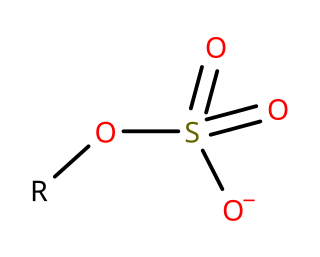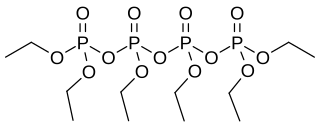Related Research Articles
Sodium laureth sulfate (SLES), an accepted contraction of sodium lauryl ether sulfate (SLES), also called sodium alkylethersulfate, is an anionic detergent and surfactant found in many personal care products and for industrial uses. SLES is an inexpensive and very effective foaming agent. SLES, sodium lauryl sulfate (SLS), ammonium lauryl sulfate (ALS), and sodium pareth sulfate are surfactants that are used in many cosmetic products for their cleaning and emulsifying properties. It is derived from palm kernel oil or coconut oil. In herbicides, it is used as a surfactant to improve absorption of the herbicidal chemicals and reduces time the product takes to be rainfast, when enough of the herbicidal agent will be absorbed.
Sodium dodecyl sulfate (SDS) or sodium lauryl sulfate (SLS), sometimes written sodium laurilsulfate, is an organic compound with the formula CH3(CH2)11OSO3Na and structure H3C−(CH2)11−O−S(=O)2−O−Na+. It is an anionic surfactant used in many cleaning and hygiene products. This compound is the sodium salt of the 12-carbon organosulfate. Its hydrocarbon tail combined with a polar "headgroup" give the compound amphiphilic properties that make it useful as a detergent. SDS is also component of mixtures produced from inexpensive coconut and palm oils. SDS is a common component of many domestic cleaning, personal hygiene and cosmetic, pharmaceutical, and food products, as well as of industrial and commercial cleaning and product formulations.

An agar plate is a Petri dish that contains a growth medium solidified with agar, used to culture microorganisms. Sometimes selective compounds are added to influence growth, such as antibiotics.

Bacteriological water analysis is a method of analysing water to estimate the numbers of bacteria present and, if needed, to find out what sort of bacteria they are. It represents one aspect of water quality. It is a microbiological analytical procedure which uses samples of water and from these samples determines the concentration of bacteria. It is then possible to draw inferences about the suitability of the water for use from these concentrations. This process is used, for example, to routinely confirm that water is safe for human consumption or that bathing and recreational waters are safe to use.

Coliform bacteria are defined as either motile or non-motile Gram-negative non-spore forming bacilli that possess β-galactosidase to produce acids and gases under their optimal growth temperature of 35–37 °C. They can be aerobes or facultative aerobes, and are a commonly used indicator of low sanitary quality of foods, milk, and water. Coliforms can be found in the aquatic environment, in soil and on vegetation; they are universally present in large numbers in the feces of warm-blooded animals as they are known to inhabit the gastrointestinal system. While coliform bacteria are not normally causes of serious illness, they are easy to culture, and their presence is used to infer that other pathogenic organisms of fecal origin may be present in a sample, or that said sample is not safe to consume. Such pathogens include disease-causing bacteria, viruses, or protozoa and many multicellular parasites.

Eosin methylene blue is a selective stain for Gram-negative bacteria. EMB contains dyes that are toxic to Gram-positive bacteria. EMB is the selective and differential medium for coliforms. It is a blend of two stains, eosin and methylene blue in the ratio of 6:1. EMB is a differential microbiological medium, which slightly inhibits the growth of Gram-positive bacteria and provides a color indicator distinguishing between organisms that ferment lactose and those that do not. Organisms that ferment lactose display "nucleated colonies"—colonies with dark centers.
A fecal coliform is a facultatively anaerobic, rod-shaped, gram-negative, non-sporulating bacterium. Coliform bacteria generally originate in the intestines of warm-blooded animals. Fecal coliforms are capable of growth in the presence of bile salts or similar surface agents, are oxidase negative, and produce acid and gas from lactose within 48 hours at 44 ± 0.5°C. The term "thermotolerant coliform" is more correct and is gaining acceptance over "fecal coliform".

MacConkey agar is a selective and differential culture medium for bacteria. It is designed to selectively isolate Gram-negative and enteric bacteria and differentiate them based on lactose fermentation. Lactose fermenters turn red or pink on MacConkey agar, and nonfermenters do not change color. The media inhibits growth of Gram-positive organisms with crystal violet and bile salts, allowing for the selection and isolation of gram-negative bacteria. The media detects lactose fermentation by enteric bacteria with the pH indicator neutral red.
A foaming agent is a material such as a surfactant or a blowing agent that facilitates the formation of foam. A surfactant, when present in small amounts, reduces surface tension of a liquid or increases its colloidal stability by inhibiting coalescence of bubbles. A blowing agent is a gas that forms the gaseous part of the foam.

Simmons' citrate agar is used for differentiating gram-negative bacteria on the basis of citrate utilization, especially for distinguishing Gammaproteobacteria of the family Enterobacteriaceae or even between species of the same genus. For example, Salmonella enteritidis would yield a positive (blue) result on Simmons’ agar and thus be distinguished from other Salmonella species like Salmonella typhi, Salmonella pullorum, and Salmonella gallinarum, which would yield a negative (green) result.

In organosulfur chemistry, organosulfates are a class of organic compounds sharing a common functional group with the structure R−O−SO−3. The SO4 core is a sulfate group and the R group is any organic residue. All organosulfates are formally esters derived from alcohols and sulfuric acid although many are not prepared in this way. Many sulfate esters are used in detergents, and some are useful reagents. Alkyl sulfates consist of a hydrophobic hydrocarbon chain, a polar sulfate group and either a cation or amine to neutralize the sulfate group. Examples include: sodium lauryl sulfate and related potassium and ammonium salts.

De Man–Rogosa–Sharpe agar, often abbreviated to MRS, is a selective culture medium designed to favour the luxuriant growth of Lactobacilli for lab study. Developed in 1960, this medium was named for its inventors, Johannes Cornelis de Man, Morrison Rogosa, and Margaret Elisabeth Sharpe. It contains sodium acetate, which suppresses the growth of many competing bacteria. This medium has a clear brown colour.

The Triple Sugar Iron (TSI) test is a microbiological test roughly named for its ability to test a microorganism's ability to ferment sugars and to produce hydrogen sulfide. It is often used to differentiate enteric bacteria including Salmonella and Shigella.

The IMViC tests are a group of individual tests used in microbiology lab testing to identify an organism in the coliform group. A coliform is a gram negative, aerobic, or facultative anaerobic rod, which produces gas from lactose within 48 hours. The presence of some coliforms indicate fecal contamination.

Endo agar is a microbiological growth medium with a faint pink colour. Originally developed for the isolation of Salmonella typhi, it is now used mostly as a coliform medium. Most gram-negative organisms grow well in this medium, while growth of gram-positive organisms is inhibited. Coliform organisms ferment the lactose in this medium, producing a green metallic sheen, whereas non-lactose-fermenting organisms produce clear, colourless colonies, i.e. Salmonella species.
The citrate test detects the ability of an organism to use citrate as the sole source of carbon and energy.
Middlebrook 7H9 broth is a liquid growth medium specially used for culture of Mycobacterium species, notably Mycobacterium tuberculosis.
Glucose phosphate broth is used to perform methyl red (MR) test and Voges–Proskauer test (VP).

Hexaethyl tetraphosphate (also known as HETP) is the organophosphorus compound with the chemical formula [(C2H5O)3P2O3]2O. The compound has not been isolated in pure form but appears to be a colorless liquid at room temperature. Commercial samples appear brown due to impurities. It is a constituent of the insecticide Bladan. In the 1940s, it was about as significant an insecticide as DDT and was referred to as "another of DDT's rivals for fame" in a 1948 book.
Diagnostic microbiology is the study of microbial identification. Since the discovery of the germ theory of disease, scientists have been finding ways to harvest specific organisms. Using methods such as differential media or genome sequencing, physicians and scientists can observe novel functions in organisms for more effective and accurate diagnosis of organisms. Methods used in diagnostic microbiology are often used to take advantage of a particular difference in organisms and attain information about what species it can be identified as, which is often through a reference of previous studies. New studies provide information that others can reference so that scientists can attain a basic understanding of the organism they are examining.
References
- ↑ Mallmann, W. L.; Darby, C. W. (February 1941). "Uses of a Lauryl Sulfate Tryptose Broth for the Detection of Coliform Organisms". Am J Public Health Nations Health. 31 (2): 127–134. doi:10.2105/ajph.31.2.127. PMC 1531262 . PMID 18015383.
- ↑ Anne Maczulak (2011), "most probable number", Encyclopedia of Microbiology, pp. 542–545